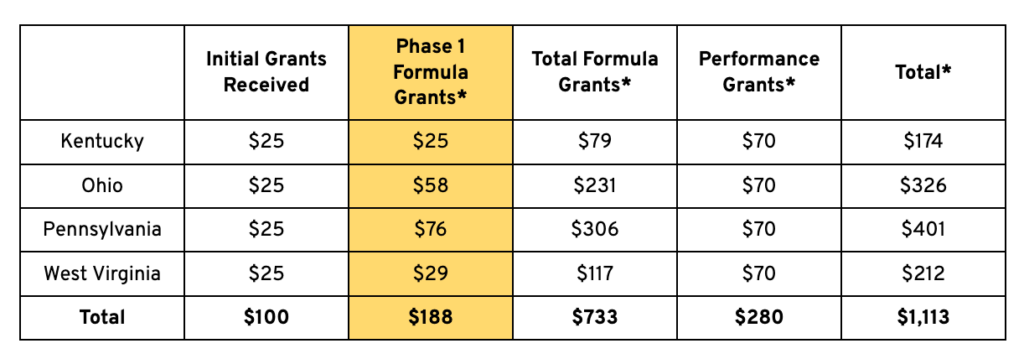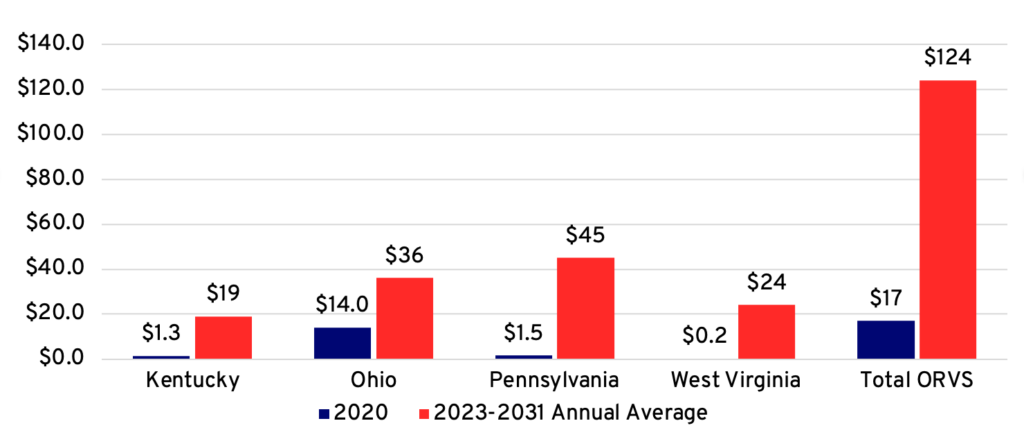Last month, the Department of Interior (DOI) released its application guidance for Phase 1 state formula grants for orphaned well clean up under the Bipartisan Infrastructure Law. The formula grants are one of three grant programs included in the infrastructure law for orphaned wells site plugging, remediation and restoration. Altogether, 26 states are eligible for about $660 million (Phase 1), or one-third of the $2 billion in formula grants over the next several years. In addition to formula grants, 24 states were eligible to receive $560 million in initial grants back in August of 2022. States will also be able to apply for performance-based grants that total $1.5 billion when the guidance on these applications are made available later this year. The purpose of the performance grants, which include regulatory improvement and matching grants, are to incentivize states to take fiscally and environmentally positive actions such as allocating state funds for orphaned well cleanup and improving plugging and abandonment practices or financial assurance.
The four states in the Ohio River Valley region – Kentucky, Ohio, Pennsylvania, and West Virginia – are eligible for $188 million (29%) in Phase 1 formula grants. Altogether, the four states could receive over $1.1 billion in federal grants to clean up orphaned wells. States could also receive unallocated funds in the future. For example, only $560 million of the $775 million in initial grant funding was allocated to states.
Table 1: Total Federal Orphaned Well Clean-Up Funds in Ohio River Valley States (in millions)

Source: U.S. Department of Interior, Section 40601 (Public Law 117-58)
*Projected funding based on potential eligibility.
Initial Grants and Ramping Up Orphaned Well Clean Up
So far, the four Ohio River Valley states have received around $100 million from initial grants to clean up orphaned wells and well sites. West Virginia has plugged about 102 of the 202 orphaned wells it is planning to decommission. Pennsylvania, which plans to plug 227 wells, has plugged 56 wells with 133 wells under contract and 38 in the bidding process. Kentucky has plugged 534 wells (so far) with additional 93 wells under contract. Ohio estimated they were going to plug between 170 to 320 wells with initial grants, but no information has been publicly disclosed.
The initial grants represent a large increase in spending for each of these four states. In 2020, these four states plugged just 467 wells, spending just $17 million, with $14 million in Ohio alone. Over the next nine years, these four states could spend a total of $124 million per year on average. The OH Division of Natural Resources estimates that they will spend a total of $634 million in state and federal funds to plug orphaned wells through 2035.
Figure 1: Orphaned Well Expenditures Ramping Up in Ohio River Valley States (in millions)

Phase 1 Formula Grants Guidance (in detail)
The official state grant guidance for Phase 1 formula grants is a significant improvement over the initial grants guidance from last year. The initial guidance did not require a detailed work plan in its grant application and many of the recommended elements in the initial grant guidance are now required. While states can use their definition of an orphaned well, which can include abandoned wells with known operators in some instances, they will have to disclose and report the wells being plugged and if they have operators still doing business.
In their work plans, the Phase 1 formula guidance requires states to provide a description of plugging standards and witnessing requirements, how salvaged material (e.g., well casing) will be dealt with, procedures for entering a landowners property to plug a well, how states prioritize orphaned wells to plug based on risk, details of each activity carried out with grant including work schedule and estimated benefits (e.g. health, safety, environment), performance goals, how information will be made public, and how the state plans to hold any potential operators or parties legally liable for the plugging costs. States are also required to provide the number and type of orphaned wells to be plugged and reclaimed, the project’s costs, offset costs from forfeiture of bonds or other assets, the number of jobs created or saved, a description of associated facilities and infrastructure (e.g. pipelines) that will be decommissioned, and the state’s definition and processes it used to identify orphaned wells eligible for plugging.
The work plans also must contain provisions around how states will prioritize wells that are the highest emitters of methane (remember this program is titled “Methane Reduction Infrastructure” in the Bipartisan Infrastructure Law) and how they will test for groundwater and surface water contamination. States will also have to indicate how input from local governments and the public will inform which wells get plugged and how they plant to locate undocumented wells and engage with third parties around well plugging.
The work plans also include provisions around how states will engage with energy workers and labor unions and how they plan to partner with workforce development programs. Remarkably, the formula guidance is asking states if they plan to incorporate high-road development strategies, such as project labor agreements, local hiring provisions, and community benefit agreements, and whether contractors are “responsible” and pre-qualified. Lastly, the work plan must include how states plan to monitor whether a plugging job was successful.
Outside of the work plan requirements, states will have to conduct pre- and post-plugging measurements for air (e.g., methane) and water pollution. This will include post-plugging inspections 12 months after the wells are plugged, including tagging each plugged well indicating the date and who plugged the well. It also clarifies that states can’t rely on the contractors that plugged the wells for this information, but it must be a state agency or a “arm-length entity” to ensure there is not a conflict of interest.
The guidance also encourages states to include workforce standards on any contracted well plugging project over $1 million. Contractors are encouraged to provide certification if the project uses a unionized project workforce, a project labor agreement (PLA) or a project workforce continuity plan. The continuity plan would detail if contractors had a well-qualified workforce, a plan for minimizing labor disputes and disruptions, safety requirements (OSHA-10), secured wages commensurate with local and regional labor markets, if the project has a Community Benefit Agreement, and whether the project prioritized local hires.
Taking the High Road on Orphaned Well Projects
The Phase 1 state formula grant guidance provides an enormous opportunity for states to ensure that orphaned well plugging projects are executed in a way that maximizes positive economic and environmental impact in states. The encouragement of high-road economic development strategies – such as project labor agreements, local hiring, and apprenticeships – are excellent additions to the previous guidance for initial grants. However, states will have to put their best foot forward to ensure that these become requirements for plugging and reclamation contracts for orphaned well clean-up projects.
A particular opportunity is the creation of a pipeline of well-trained workers that can take advantage of the enormous growth in plugging projects associated with the $1.1 billion in funding. Up until now, plugging wells was a small boutique with only a handful of companies engaged in this work in Appalachia. Some states are taking proactive steps to ensure that these are good paying jobs and that there will be a well-trained workforce to clean up orphaned wells today and well into the future.
Last month, Pennsylvania Governor Josh Shapiro announced an executive order to create an on-the-job (OTJ) training grant program – the Commonwealth Workforce Transformation Program – using 3%(estimated around $400 million) of funds from the Bipartisan Infrastructure Law (BIL) and the Inflation Reduction Act (IRA). This could mean $9 million alone for training workers to clean up orphaned wells in Pennsylvania. The funding provides a grant of $40,000 per new employee or $400,000 per project to organizations (e.g. private contractors) that receive BIL or IRA funds and use those funds for job training costs (e.g. wages or apprenticeship costs). These funds could play a large role in the creation of the state’s first union apprenticeship program for well plugging and reclamation, if contractors partner with local building trades like the operating engineers.
The state of California is a couple of steps ahead of Pennsylvania with incentivizing union apprenticeship programs for well plugging services. Last year, the California Workforce Development Board, as part of its High Road Training Partnership, launched an oil and gas well capping pilot initiative in Los Angeles and Kern Counties with $14.3 million in funding. The funds can be for training apprentices and upskilling journeypersons on well plugging projects. Last summer, California Legacy Well Services (a union contractor) received $6.4 million to develop an apprenticeship program.
The California Department of Conservation (CalGEM), which runs the state’s orphaned well program, released a draft expenditure plan outlining how state and federal funds will be used to plug orphaned wells in the state. The plan includes several high road labor standards, including requirements that all plugging and reclamation work must comply with “apprenticeship utilization requirements” and that by 2028 all contractors will have to enter into project labor agreements with a skilled and trained workforce.
Other states in Appalachia would benefit tremendously from following California and Pennsylvania’s lead in ensuring that workers are getting the training and skills they need to engage in what will be a large and growing industry over the next several decades.

